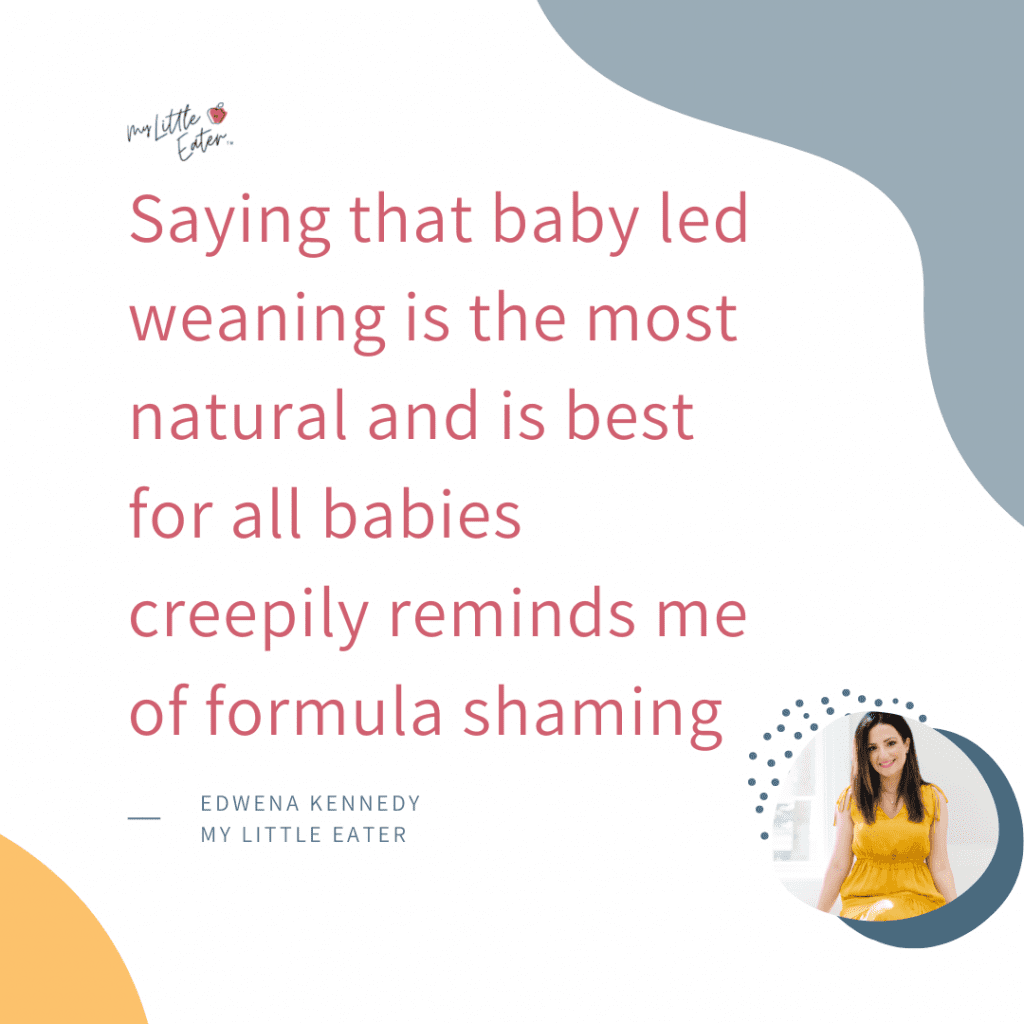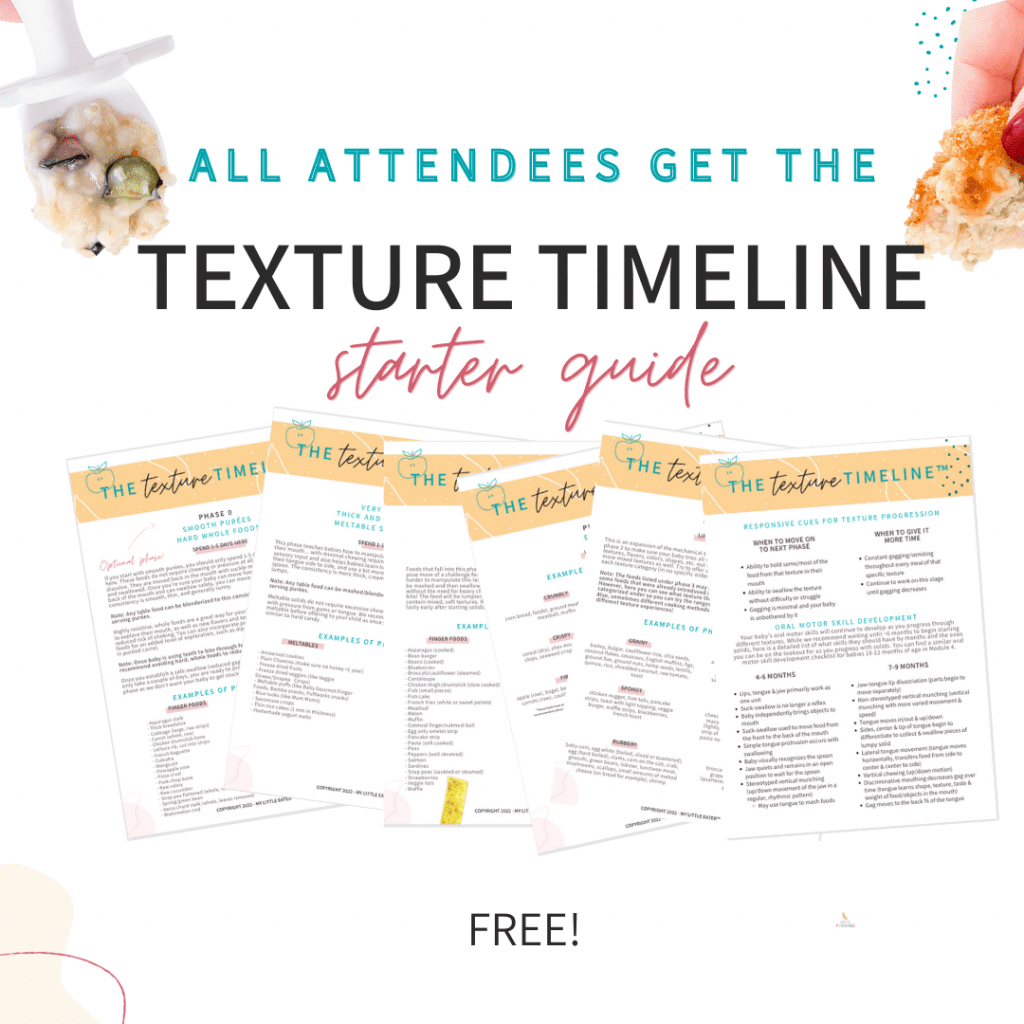We get that starting solids can be scary. We know it can feel overwhelming.
Whether starting with purées or finger foods, it’s not easy to jump from feeding your baby a diet exclusively made up of milk, to starting to add solids that are textured, advanced and big in size!
And so being told that you should be starting solids with all types of finger foods from day 1 doesn’t resonate with everyone.
The truth is, you don’t have to.
We believe you should start solids where you’re ready and advance from there using our Texture Timeline™! This tool has been used by tens of thousands of parents since it was first created it in 2017, inside our Baby Led Feeding online course, as a way for parents who are offering purees or finger foods, to continually advance to more variety in textures, without rushing too fast or feeling fear.
And now we’re sharing about it here, and teaching you all about how it works.
For more info about how to move from purees to finger foods in a more gradual way, overcome fears of gagging/choking/big bites, and learn more about the Texture Timeline™ – sign up for our FREE workshop below!
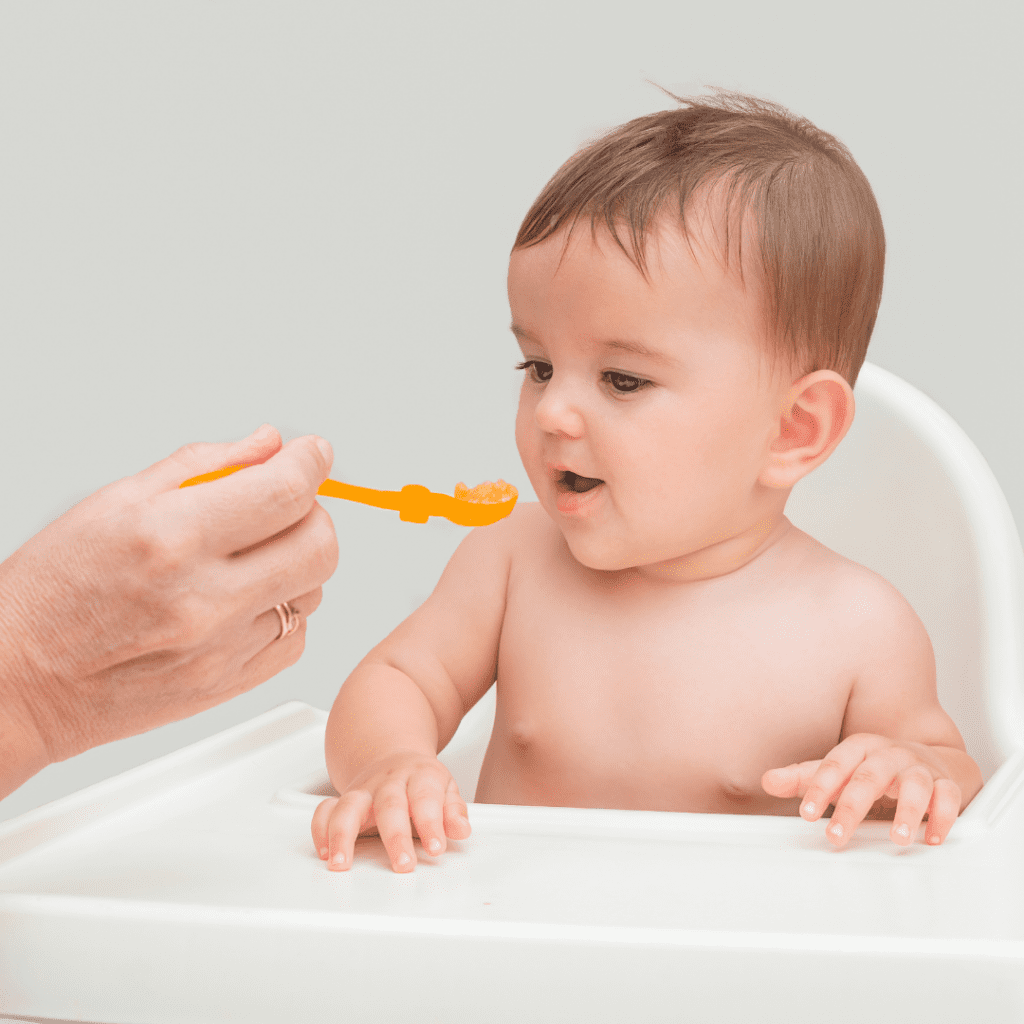
WHAT IS THE TEXTURE TIMELINE™?
The Texture Timeline™, created by Registered Dietitian Edwena Kennedy in 2017, is our signature tool for helping parents and caregivers who want a more gradual approach to starting solids. It shows you how to transition to solids by easing into textures and more advanced finger foods in a way that keeps you (the parent) feeling comfortable, while at the same time, challenges your baby ever so gently and in a timely way. It has been consulted on and vetted by some of the top Speech Language Pathologists in the industry.
It categorizes food in different phases, starting with serving easier, to more and more advanced textures (purées or finger foods), so you can ensure:
- Your baby gets continuous exposure to a variety of textures in a timely manner
- You’re keeping your baby advancing in skills to prevent picky eating
- You’re easing into different purées and finger foods in a way that keeps you calm and allows you to build your confidence
- You’re overcoming any fear of gagging by taking action every day
It’s perfect for parents or caregivers who want to start solids with purées (but understand the importance of not getting stuck there). It’s also perfect for parents who may have already started with purées or finger foods, but are afraid of progressing in textures due to fears of gagging, choking, or big bites. Finally, the Texture Timeline™ is a wonderful tool for babies who aren’t ready, or for whom it’s not safe to start on finger foods from day 1.
Let’s go over the main features of the Texture Timeline™ and how it works in more detail. To see it in action, follow along as we share our realistic example of the first week of starting solids.
Why you might need the Texture Timeline™
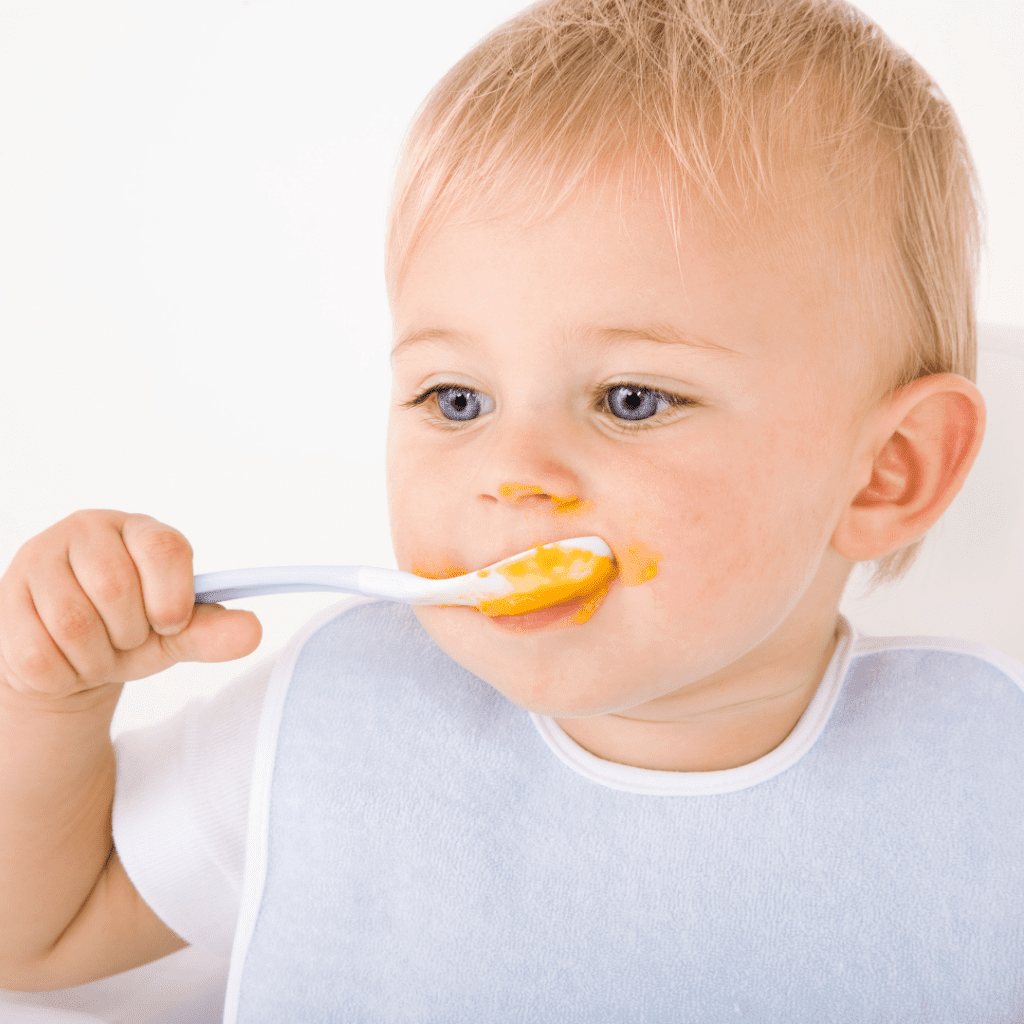
As soon as Baby Led Weaning started becoming a mainstream and popular method of starting solids, Edwena recognized the need to create the Texture Timeline™. While Baby Led Weaning is an amazing way to start solids that has many benefits, it was becoming clear that the messaging in the feeding world started to turn towards the idea that this method was the most “natural” and “most enjoyable” and “most beneficial” for babies.
Purée feeding started becoming synonymous with images of babies being pressured into eating, babies crying at the highchair and babies turning picky. This in turn, made many parents she was speaking to increasingly feel pressure, judgment and guilt for not being able to (or not wanting to) start with finger foods and do “true baby led weaning” from day 1 of starting solids.
We actually know that this isn’t true at all. The reality is that purée feeding can be just as natural, enjoyable and beneficial as baby led weaning. In fact, taking any method of parenting and making it forceful isn’t going to have good results on the child.
When feeding is done responsively (to your baby’s cues), you can do either method of feeding with the exact same outcomes. You can also mistakenly do either method in a way that doesn’t yield optimal results. You can learn more about our baby led feeding philosophy on starting solids here.
Here’s the gist of things.
Babies can start solids with either purées or finger foods.
Both methods (which are encompassed in our Baby Led Feeding Method) need to include positive, pressure free family meals, a variety of nutritious foods, progression in textures, and the ability to follow baby’s cues for appetite, enjoyment, and sense of independence. Both methods need to provide ample opportunities for babies to advance and develop their eating and chewing skills.
We want babies to experience as much variety in textures and flavors within the period of 6-9 months as possible (also known as the critical period for developing taste and texture preferences).
How you start solids doesn’t matter as much as how you progress.
In order to make sure that babies (and parents) can start where they like, and yet are progressing in textures and variety of foods in a timely manner, the Texture Timeline™ is there as your guide to provide ideas and an accountability structure.
All of this is covered, in detail, in my Baby Led Feeding online course.
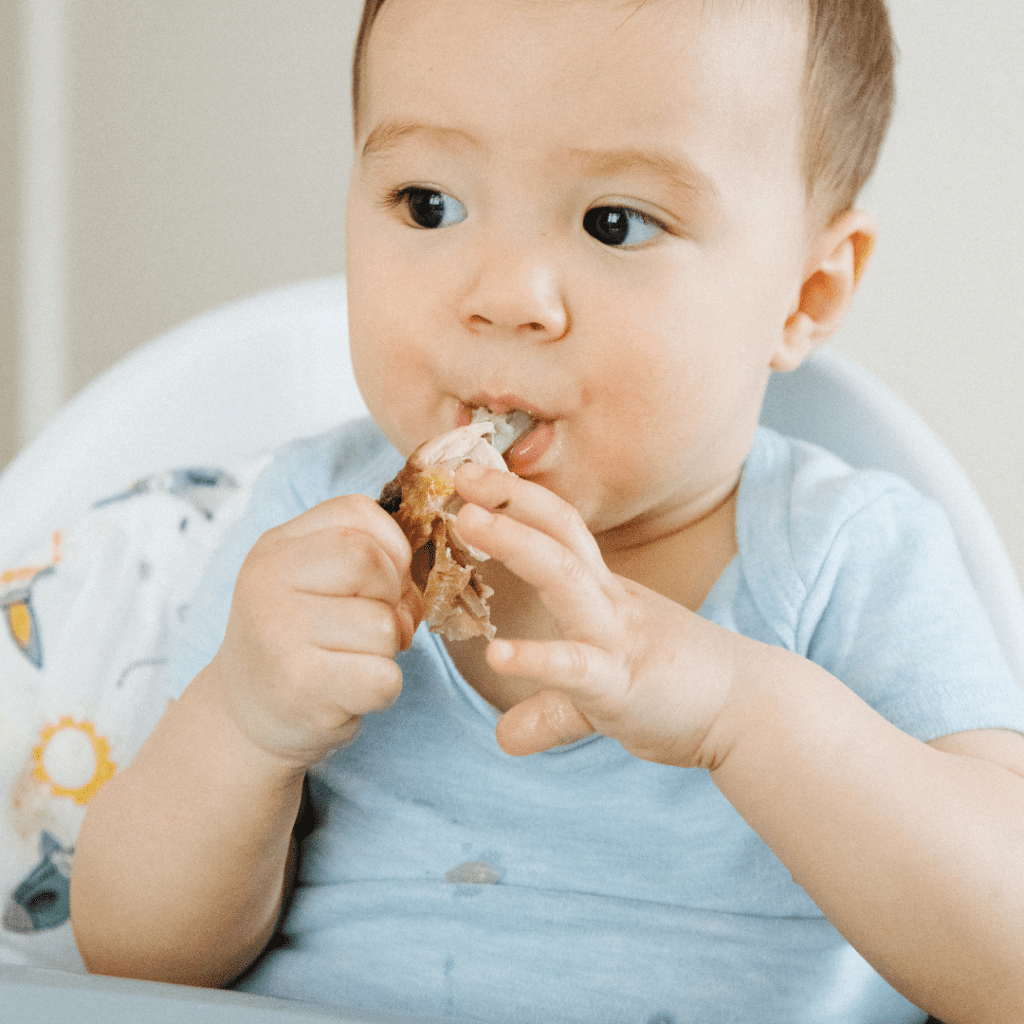
The truth is, the majority of parents are afraid of introducing more advanced textures and finger foods. It’s a huge jump to make from an exclusively liquid milk diet to finger foods. To say they “should be able to” is ignoring the fact that it is very scary, despite being educated on how to do it, and can cause a lot of anxiety for parents and caregivers alike.
This is something we strongly believe should be respected and that parents should be helped through with a step-by-step process. Building confidence around baby’s abilities to eat, and overcoming very real fears of gagging and choking, needs some time, attention and empathy.
The other reality is that sometimes babies themselves need to be eased into more advanced purées and finger foods. To say that all babies can or should be able to start on finger foods from day 1 is simply not true – and again – many parents feel as if something is wrong with their baby if they don’t take to it for many weeks or a couple months.
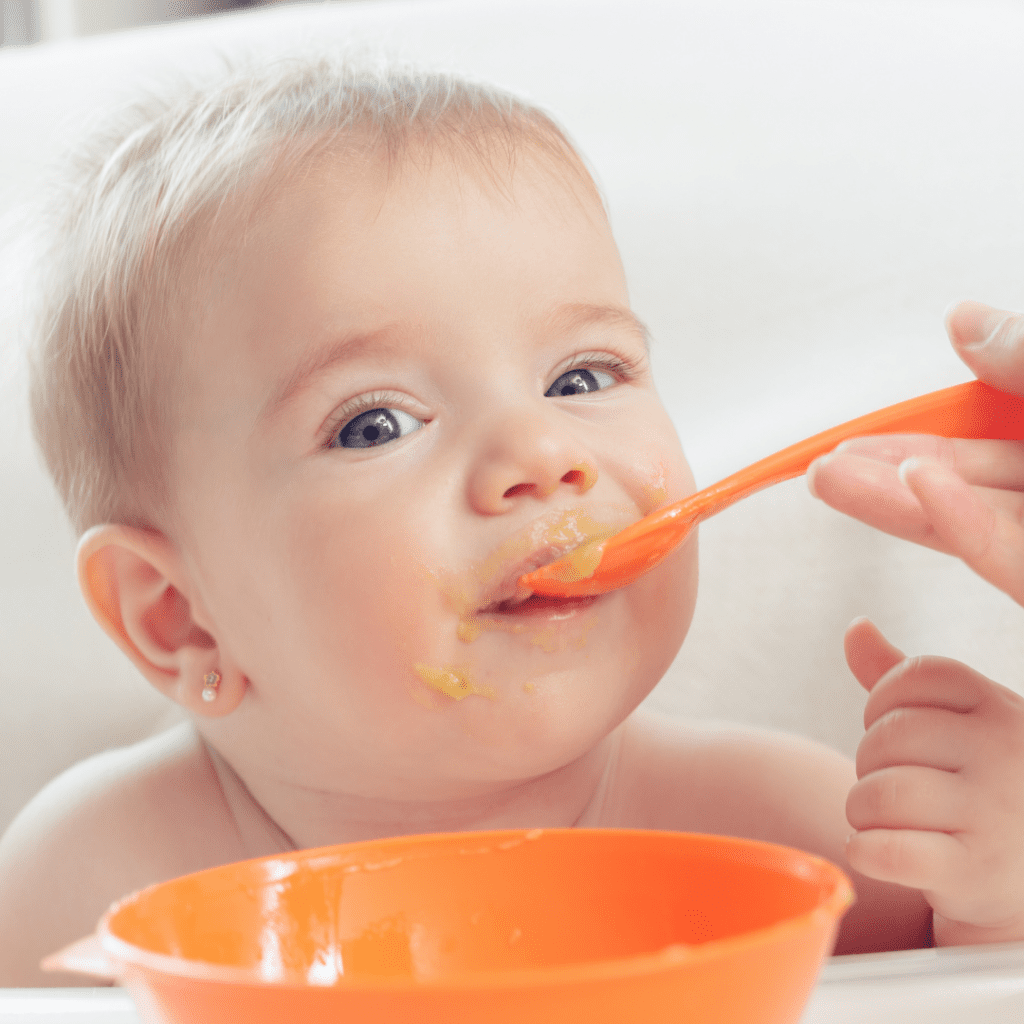
Baby may not be interested in grabbing finger foods but is otherwise ready to start solids. Other times it’s a developmental delay that prevents babies from being able to self-feed or handle any and all textures. Some babies may need the nutritional support of purées in the first few months for sufficient allergy introduction, high iron food intake, or for meeting calorie needs.
The Texture Timeline™ allows parents to offer purées and very soft, easy finger foods without getting stuck.
As we always say, there are two parts of the feeding equation…parents and babies. We need to respect the needs of both and we’ve got that covered with the Texture Timeline™.
How the Texture Timeline™ works
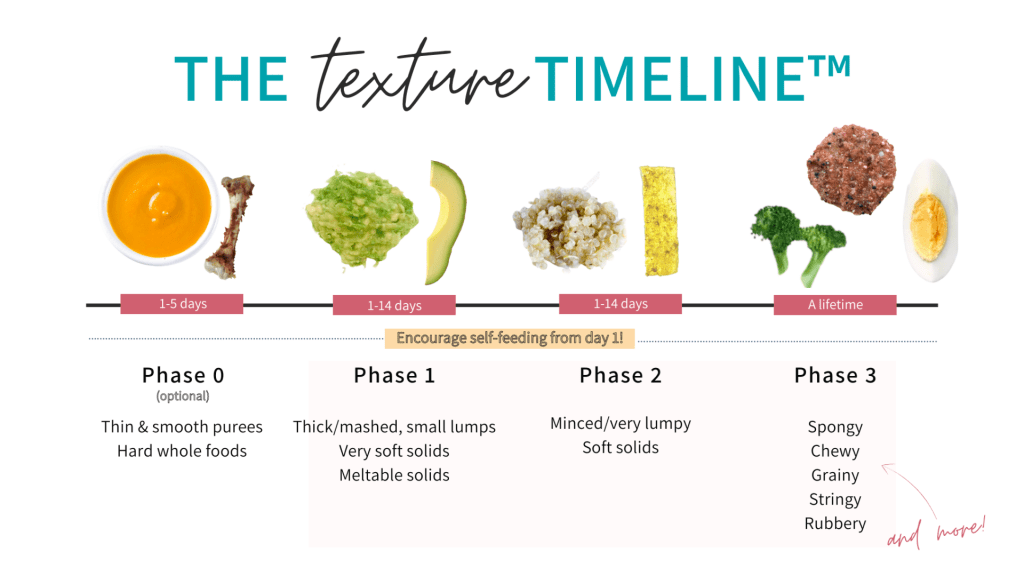
The Texture Timeline is marked by four general phases to work through – Phase 0, Phase 1, Phase 2 and Phase 3.
Phase 0 is actually an optional phase – you can start there if you’re extra nervous, while others feel comfortable enough to start on phase 1, phase 2 or (if jumping into full on baby led weaning), Phase 3! The beauty is that it’s customizable to you and your baby’s needs. It doesn’t matter where you start, this is just to help guide you from where you are to where you want to be.
Each phase has a general time babies may want to stay there for (ex. 1-5 days, 1-14 days, a lifetime, etc.), because remember, you want the transitions to be timely. We want to give you and your baby enough opportunity to slowly transition from one texture to another, feel comfortable, but at the same time, once your baby has mastered a texture, we don’t want to get stuck in one phase for too long.
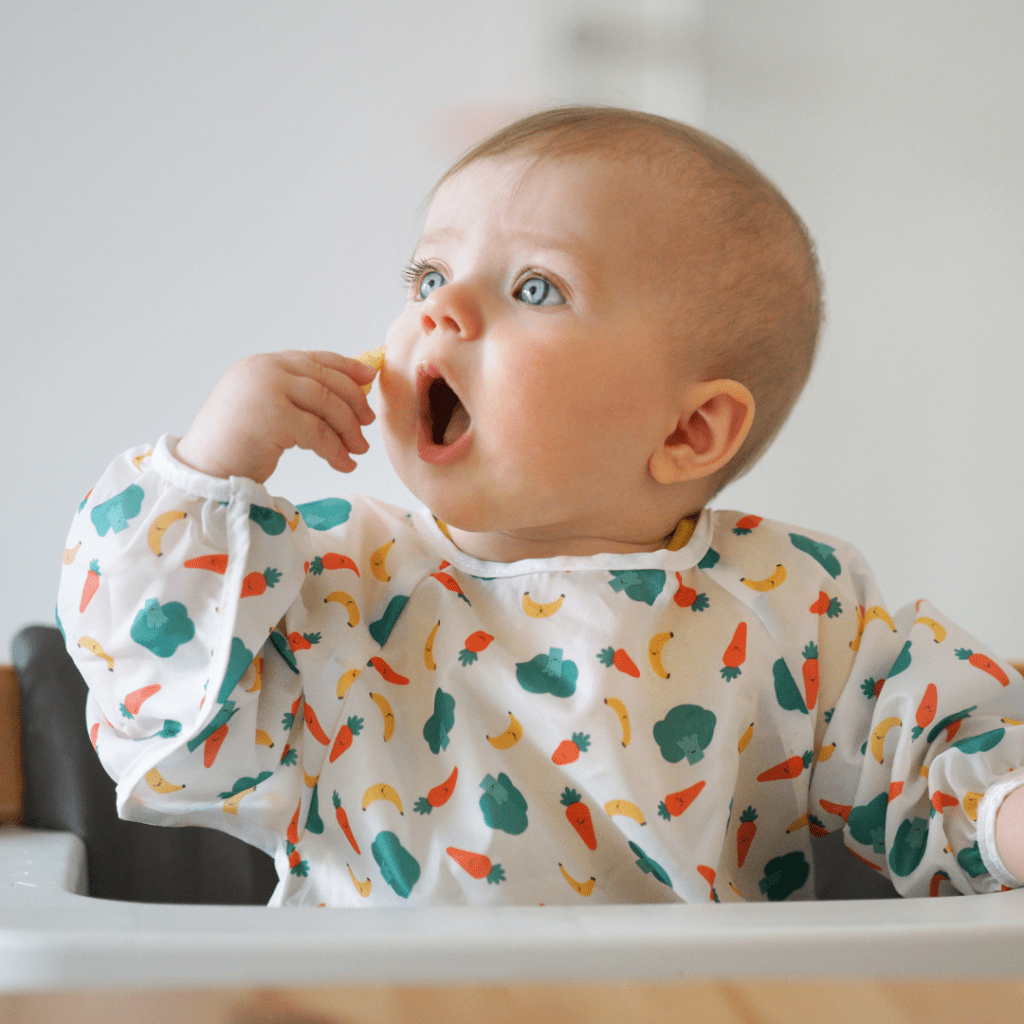
Our job as parents is to gently challenge babies to advance in feeding skills once we see that they’ve already mastered a simpler one. So this is just a good guideline to get you at all foods and textures by 8-9 months of age. Some people might only spend a few days in a phase and are ready to move on. Others might want to spend a bit more time to get used to things for longer, and that’s totally fine!
One other note to reiterate. The Texture Timeline™ takes into account that you might be starting with purées or you might be starting with finger foods. Each phase incorporates both options and the difficulty level will progress so that by phase 3 (no matter how you started)…all foods will look one and the same.
The Phases of The Texture Timeline™
Phase 0 - Thin & Smooth Purees/Hard, Resistive Foods (0-5 days)

Thin, smooth purées do not require chewing or pressure at all for it to dissolve. They are moved back in the mouth with suckle movement and swallowed. Once you’re sure your baby can move food to the back of the mouth and can swallow safely, you can move on! The consistency is smooth, thin, and generally runny.
Note: Any table food can be blended to this consistency, if serving purées.
You can also offer highly resistive, whole foods as a great way for your baby to begin to explore their mouth, as well as new flavors and textures with reduced risk of choking. You can also incorporate purées onto the foods for an added level of exploration, such as dipping raw carrot in puréed carrot.
Note: Once baby is using teeth to bite through foods, we recommend avoiding hard, whole foods to reduce the risk of choking.
Once you establish a safe swallow (reduced gagging), which may only take a couple of days, you are ready to progress to the next phase as we don’t want your baby to get stuck here!
Phase 1 - Thick/Mashed with Small Lumps or Meltable Solids (optional) or Very Soft Solids (1-14 days)

This phase teaches babies how to manipulate a thicker texture around their mouth… with minimal chewing required! It provides more sensory input and also helps babies learn how to bite into finger foods, move their tongue side to side, and use a bit more effort to remove food from a spoon. The consistency is more thick, creamy, stiff, and may contain small lumps.
Note: Any table food can be mashed/blenderized to this consistency, if serving purées.
Meltable solids do not require excessive chewing and dissolve in your month with pressure from gums or tongue. *We recommend caregivers test the meltable before offering to your child as once stale, these foods can become similar to hard candy.
Very soft solids require steaming, roasting, boiling, or baking to make into a very soft texture that requires minimal chewing. You should be able to mash between thumb and finger easily. Any seeds or tough skins (e.g. apple skin) should be removed. If not, some of these foods may pose an increased risk of choking.
Note: It’s extremely important you are familiar with how to safely prepare all foods before offering them to your baby. For more information, check out the Texture Timeline™ Food Library in the Baby Led Feeding course for video examples and instructions.
Phase 2 - Very Lumpy or Minced, Soft Solids (1-14 days)

Foods that fall into this phase are still soft and squishable but pose more of a challenge for babies because they have to work harder to manipulate this texture in their mouth. These foods can be mashed and then swallowed, or break apart easily in the mouth without the need for heavy chewing – but still has a bit more of a bite!
The food will be lumpier, more irregular in shape, and may contain mixed, soft textures. Most babies can tolerate this stage fairly early after starting solids, or even as the first texture offered!
Phase 3 - EXPAND (a lifelong phase)

This is an expansion of the mechanical textures listed in phase 2 to make sure your baby tries all the various textures, flavors, colors, shapes, etc. out there! It includes more mixed textures as well. Try to offer a variety from each texture category (in no specific order).
Texture categories include:
- Grainy – like quinoa
- Rubbery – like mushrooms
- Spongy – like toast
- Stringy – like pulled meat
- Chewy – like tortilla
- Crunchy – like grapes
- Crumbly – like a muffin
- Crispy – like a cracker
- Leafy – like cooked spinach
- Mixed – like lasagna
Note: The foods listed under phase 3 may also include some foods that were already introduced in phases 1 & 2 (although those are easier to chew). However, here you can see what texture they’re categorized under so you can try the ranges in one place! Also, sometimes different cooking methods can produce different texture experiences!
What specific foods fall under each phase of the Texture Timeline™?
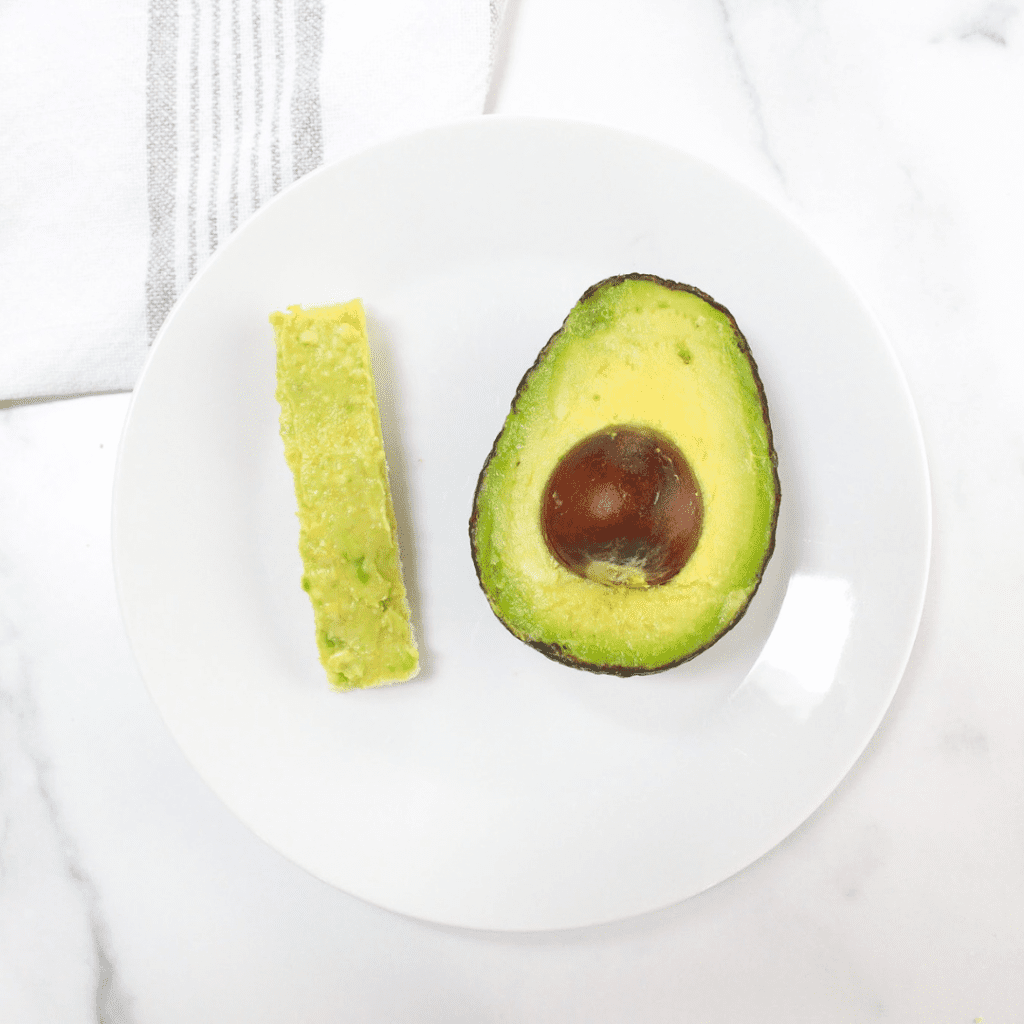
Inside our Baby Led Feeding course, we have a list of over 100 foods that are categorized within each texture phase, so you can have plenty of options for foods to work through based on your comfort level and your baby’s skills. We also have a Texture Timeline™ Video Library (still under construction but updating weekly!) that provides you with videos showing how to serve a food based on the corresponding phase of the Texture Timeline™!
For some initial guidance and some starter foods to try for each category phase, you can get a free copy of the Texture Timeline™ Starter Guide in our (also free) workshop called “Baby Led Weaning…but make it purées! How to move from purées to finger foods – without the fear!”.
A Word on Self-Feeding
Encouraging self-feeding skills is also a big part of the Texture Timeline™. It’s important to give your baby opportunities to self-feed as soon as they show cues of being able to/want to (just like it’s important to progress in textures based on baby’s cues).
There are SO many benefits to self-feeding from a young age, so even if you start out spoon feeding purées, you’ll want to watch for signs that your baby’s ready to become more independent in feeding and offer them the opportunity to try finger food alongside purées at mealtimes. This promotes curiosity and independence to support positive mealtime experiences! Learn more inside the Baby Led Feeding Course.


about the author
EDWENA KENNEDY, RD
Founder and lead Registered Pediatric Dietitian at My Little Eater Inc., creator of The Texture Timeline™, and mom of two picky-turned-adventurous eaters.
